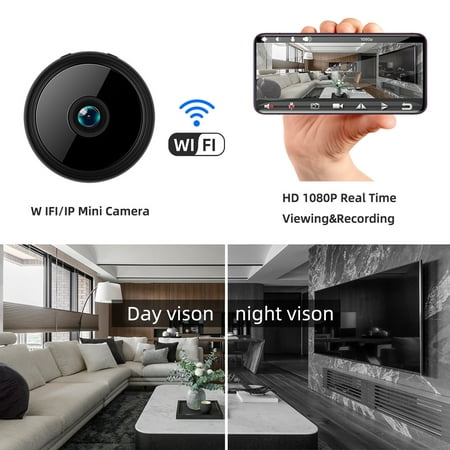1080P HD Mini IP WIFI Camera Magnetic Camcorder Wireless Home Security Car DVR Support Night Vision Video Recording Motion Detection, APP Remote Control, 150° Super Wide Angle
Description:First,make certain the battery absolutely charged,press the pink/blue mild on/off,and then press and preserve the mode.Just wait for the pink mild to seem.GUARD YOUR HOME SECURITY ANYTIME ANYWHEREWIDE VIEWING ANGLE, NEVER MISS ANY DETAILWith a a hundred and fifty-diploma viewing anglethe camera gives a extensive viewing range to your room.It enables you to realize every motion happened in your house every time everywhere.ALL-PURPOSE MAGNETIC, EASY TO FIXA built-in magnet with a magnetic base can stick anywhere you need.ENHANCE NIGHT VISION, SEE CLEARLY IN THE DARKFEATURES- 1080P Full HD Brings You A Different Experience.This wi-fi IP camera helps you to view actual-timewhat’s happening internal your private home or workplace evenwhile you’re away on a vacation or a brief commercial enterprise ride.The faraway view can be accessed thru theAPP(V380PrO) the use of iOS and Android smartphones.This wi-fi IP camera can paintings on WiFi (2.4GHz WiFi only) or No WiFi.When it works on No WiFi, insert a Micro SD card (SD card not encompass) and activate,the digital camera will recording and saves the video documents to the SD card (SD card no longer include).- Night vision & movement detection & alarm push,the ones features are the basis for this indoor protection digital camera.You can not only see things inside the darkbut additionally seize everybody who is moving in the digicam.- This small digital camera toilet has a built-in magnet,can paintings nicely with any iron fabric, easily vicinity everywhere.This small camera with a inflexible charging cable and magic base,whilst charging while recording, you can manually rotate the recording perspective 360 degrees.Specifications:Material: Aluminium alloySize: five*4.5*4.5cmColor: blackResolution Ratio: 1920*1080PVideo Format: AVIMemory Card Type: support Micro SD card as much as 128GB, (TF isn’t always covered)Compressed Format: H.264APP Support: Android/iOS150°Wide-angleBattery running time: one hundred twenty minutesSupport Night model? yesWifi managed via Cellphone or computerHow To UseDownload the APP(V380PrO) in APP Store or Google Play.Press the ON/OFF button about three seconds to show on the camera.Find and join the camera wifi hotspot for your phone WLAN setting.Or, experiment the digicam QR/ID Code and connect your home2.4GHz wifi in the App Device Settings-WiFi Config.Watch the stay video.If you need to save the video, layout the micro SD card earlier than the usage of it.Notice:1. Connect the digital camera to the cell phone.The digital camera and the mobile cellphone do not want an ID, only need to be in the same WIFI state.After downloading and app registration, you will get the Item ID.2. Camera and pc connectionWhen the camera and computer are in the equal WIFI state, you don’t need Item ID.To use the Item ID to hook up with the computer, you want to register with your cellular smartphone to get the Item ID.3. In order to prevent the Item ID from being stolen, the product gets the Item ID after registering with the APP.4.Please make sure to use a 5V/2A data cable for charging.Package Included:1 x WiFi wireless camera1 x Magnetic bracket1 x Metal tab2 x USB Cables1 x Instruction Manual

















Portable cell hotpots used indoor/outdoor150 degree wonderful extensive angleAPP remote control, cellular detection & remote alarm, night vision/voice/Screenshots/clarity adjustmentsHD 1080P video recordingBuilt-in magnet, matching magnetic fittings, and it’s miles suitable for a diffusion of activities





Reviews
There are no reviews yet.